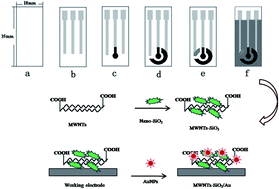Development of a novel and simple method for clinical therapeutic drug monitoring of aminophylline in humans based on a MWNTs-SiO2/Au composite modified screen-printed electrode
Abstract
Aminophylline is a drug that needs therapeutic drug monitoring in clinical treatment. A novel disposable screen-printed electrode (SPE) modified with MWNTs-SiO2/Au composites for the determination of aminophylline concentration in blood samples was developed. The electrochemical performance of aminophylline at the MWNTs-SiO2/Au SPE was explored by cyclic voltammetry (CV) and square wave voltammetry (SWV). The optimum experimental conditions were obtained and the currents of aminophylline presented a good linear property with the increasing of the concentrations under optimized conditions. The linear range of aminophylline was from 5 μM to 200 μM with a detection limit of 0.5 μM (S/N = 3). The results of clinical blood samples showed good sensitivity and selectivity of the prepared sensor. Moreover, the drug concentration-time curve of aminophylline in clinical patients was attained at different time points such as 0.5 h, 1 h, and 2 h by the proposed method. The results strongly suggested that the established sensor could be used for practical monitoring in clinical individualized treatment.


 Please wait while we load your content...
Please wait while we load your content...